Long Islanders find themselves changed in drive to help poor Nicaraguans
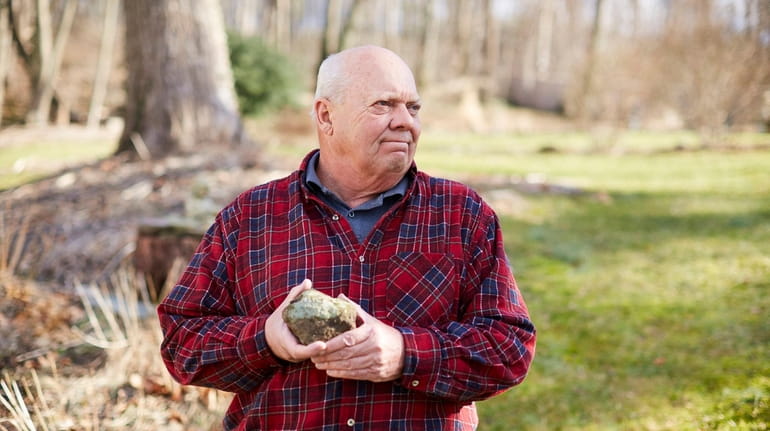
Peter White, co-founder of Friends of Students for 60,000, a group dedicated to helping poor Nicaraguan villages by building new homes and providing clean water, talked about his work at his home in Centerport. The rock in Peter's garden is from Nuevo Amanecer, the village the Friends helped out with the water project. It was given to him by the leader of the community to remember them by. "I pass it every day when I go outside and it reminds me of the struggles of the poor," White says. "It helps keep things in perspective." Credit: Yvonne Albinowski
Once or twice a year, 83-year-old Joanne Moran boards a plane and heads off for a tropical vacation with friends. Upon landing, she climbs into a pickup that bounces along rutted roads that “make you feel like your guts are going to fall out,” then pulls up to a Nicaraguan village. Over the next week, she mixes cement, hauls rebar and lugs cinder blocks for either a tiny home or a latrine. At day’s end, she is filthy, drenched in sweat and braces herself for a cold bucket bath before collapsing onto a cot for the night. The next morning, she shakes out her shoes (she once found a tarantula in her room) and goes back to work.
Returning home, she always has the same wistful feeling.
“I can’t wait to go back,” she says.
To some, this might sound like an exotic holiday gone terribly wrong. In fact, it describes a common experience among a group of Long Islanders known as the Friends of Students for 60,000 — many seniors you would expect to find in a lounge chair rather than shoveling out the foundation for a privy — on a mission to help dirt-poor Nicaraguan villages.
Over the years, they have built homes, schools, sports fields and lit up the darkness with electricity. They have bought land, cows, chickens, tractors and doubled the number of children attending elementary school (tripled in secondary schools) by providing them with clothing and supplies. One of their most dramatic accomplishments involved a village sickened by contaminated water that, working alongside Northport high school students and with aid from other philanthropic groups, they helped relocate to an area with pristine water from a volcanic spring.
Life altering? You bet, says Moran. For everyone.
“No one goes down there who doesn’t come back changed,” she says.
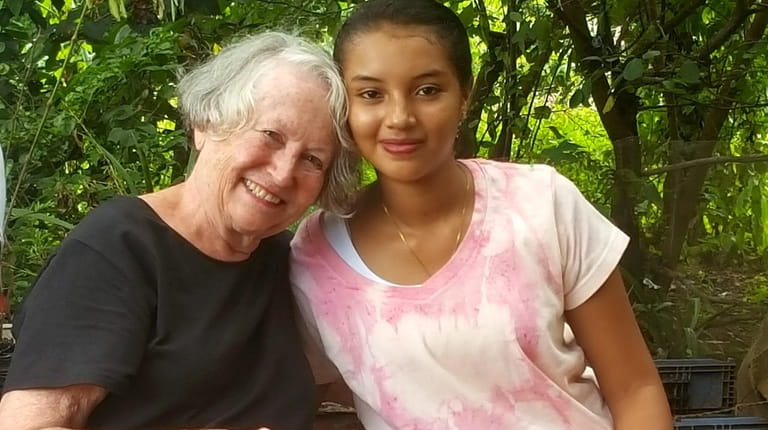
Joanne Moran, left, poses for a photo in 2018 with Hlvetsitha Poveda, 17, the eldest of Moran's three "granddaughters" in Nicaragua. Moran is a member of Friends of Students for 60,000, which built a home for Poveda's family in 2013; the daughters in the family have since "adopted" Moran as their grandmother. Credit: Peter White
Roots in student altruism
The story behind this dates more than three decades ago to a Northport High School organization called Students for 60,000, named for the estimated number of homeless in New York City at the time. The student group was supervised by a sparkplug social studies teacher named Peter White, 72, along with inspiration from Dick Streb, the former social studies chairman, who died in 2007. In 1990, Streb talked White into traveling to war-torn Nicaragua. White needed to “stretch his mind” about other parts of the world, White recalls Streb telling him back then.
It was stretched.
“I had never seen anything like that,” White says, describing breaking into tears when he saw the degree of deprivation. “I was also embarrassed. At that point, I’d been teaching for 20 years and I didn’t know how half the world lived.”
The student group continued its humanitarian efforts in the New York metro area, but began adding chaperoned trips to Central America, primarily to villages in an impoverished area near Leon, Nicaragua's second-largest city. Newsday sent reporters along to do a story about the group in 1992.
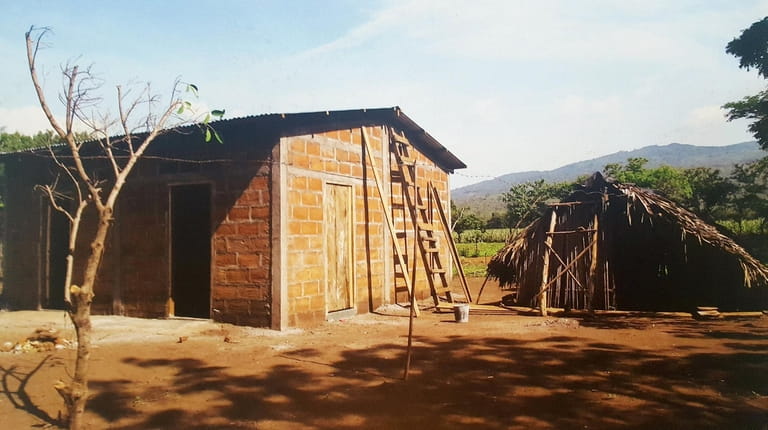
Two houses sit side by side in Nuevo Amanecer, Nicaragua. The old one, on the right, is a family's former residence; the new one was built by the Friends of Students for 60,000 to replace it. Credit: Friends of Students for 60,000
These days, the students pursue a variety of causes locally and nationally, including trips to Puerto Rico, West Virginia and El Paso, Texas, but they have not returned to Nicaragua since 2018 because of political unrest. The Sandinista government’s clash with opposition forces in recent years has led to numerous deaths, and the U.S. government warns citizens not to travel to the country.
After White retired in 2005 (he was New York State “Teacher of the Year" in 1999) he formed a nonprofit organization the next year to carry on the work and act as a bridge for students who wanted to continue their efforts as adults. Thus was born Friends of Students for 60,000, a core of around 30 people who travel to Nicaragua for actual labor supported by a hundred or so others who do fundraising.
“These are the people who do the heavy lifting,” White says.
Kate Shreck, an 82-year-old Northport real estate agent and former nun who became the co-director (with White), also is jolted each time she visits. Especially when she sees hungry campesinos wearing rags and living in corrugated shacks with no bathroom. The feeling stays with her to the point that she feels guilty taking a hot shower when she returns home.
“We have so much here,” she says. “We think we need it, but we don’t. Unfortunately, the feeling wears off.”
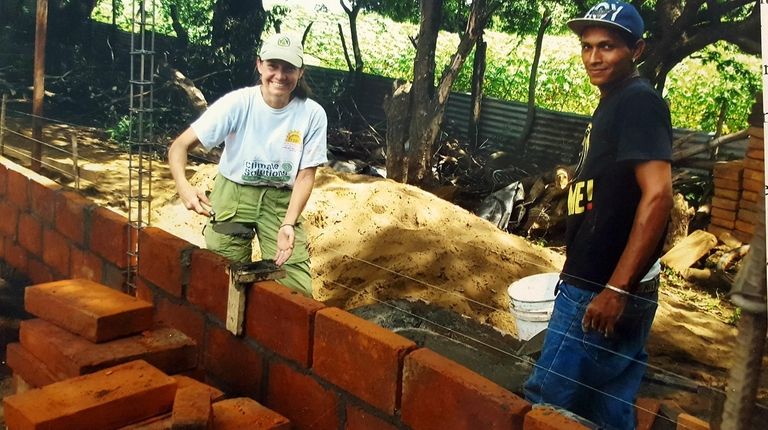
A member of Friends of Students for 60,000 and Northport High School graduate, Elisa Zazzera, left, works to lay bricks for a new house during a 2016 trip to Nicaragua. A local contractor supervized the construction of the home, which replaced a dilapidated plastic shack with only three walls and one side open to the elements. Credit: Peter White
Focused on three villages
A typical work day in Nicaragua begins with a breakfast of rice, beans and fruit provided by cooks hired for the week, then it’s off to the designated project. If a house, they first dig out a foundation (supervised by a local laborer with contractor experience), enclose it in concrete blocks and shelter it with a corrugated roof. Creating a well is another labor-intensive project, which locals take over as the depth increases. Completing a latrine — one of the most common necessities, since the alternative is using a field as a toilet — requires more digging in hard-packed earth.
The heat is palpable, according to Shreck.
“It gets to you so much it’s hard to breathe,” she says. “Then, it gets chilly at night.”
The Friends' efforts have focused on three villages, all so remote and poor only one — Chacraseca — can be found on a map. Most of the work has involved building homes, but one of the more challenging came in a village called Nuevo Amanecer, the most desperate of the three. Its population was constantly sickened by polluted water, but was too poor to do anything about it. White was horrified when he saw a shallow opening filled with pea-green water and a rat swimming in it that served as the water supply.
“You can’t drink that,” he told the onlookers.
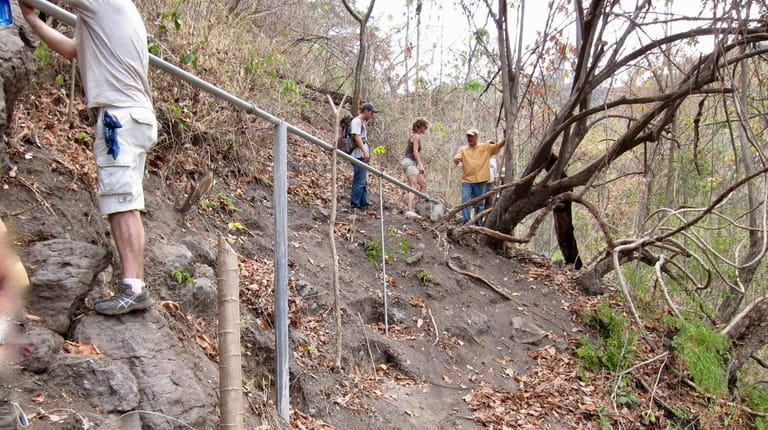
Friends of Students for 60,000, with help from the municipality of Telica, Nicaragua, and hydraulics technical assistance from a British nonprofit, built a pipeline to tap a spring midway up a nearby volcano. By the project's end, the people of Nuevo Amanecer were at last able to drink clean water from a system that serves their needs and supplies water to nearby townships -- around 450 families in all. Credit: Bill Ofenloch
An old man stepped forward.
“No, you can’t drink that,” he told him. “We have to.”
Over several years, the Friends and Northport students raised money and pitched in to create houses and buy 70 acres a few miles away where most of the population was able to move. With help from the municipality of Telica and hydraulics technical assistance from a British nonprofit, a pipeline was built to tap a spring midway up a nearby volcano. By the project’s end, the people of Nuevo Amanecer were at last able to drink clean water from a system that serves their needs and supplies water to nearby townships — around 450 families in all.
“Their generosity has changed and continues improving lives in a Third World country, the No. 1 poorest in Central America,” says Marbely Rios Miranda, the mayor of nearby Telica.
Houses built by the Friends usually run about $2,650, including a latrine, White says. After each project is done, the tools are handed out to the villagers. At the new Nuevo Amanecer site, they helped build homes for the transplanted families and contributed $50,000 to complete their water project in 2014.
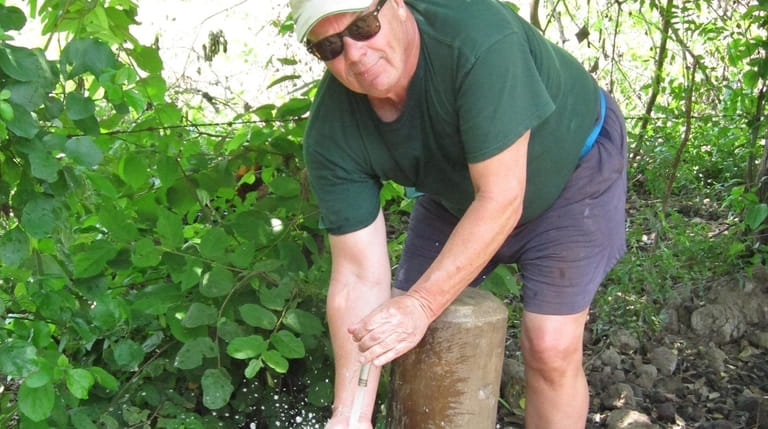
Peter White holds his hands in front of the water spigot that delivers potable water from the Telica volcanic spring to Nuevo Amanecer, Nicragua. Credit: Bill Ofenloch
Naturally, Friends members have developed relationships with the Nicaraguans.
A few years ago Moran, a former New York casting director who later taught communications at Nassau Community College, helped build a home for a family with three small daughters. When the group returned, the family invited them over to see the house had been maintained and the garbage-strewn surroundings replaced by a lawn. When the Friends realized the family had only one bed for the five of them, they chipped in $50 to buy cots for the three girls, who have kept in contact with Moran.
“Now, they write to me in Spanish and call me grandma,” she says.
When a 12-acre plot of land bought by the Friends a decade ago was turned into a children’s playground in addition to sports fields, the locals named the baseball field after one of Shreck’s sons who died unexpectedly as an adult. Sports is always a draw, says White. Sometimes they bring a suitcase of baseballs to give away, helping speed their way through officialdom at airports.
“They’re like gold,” White says.
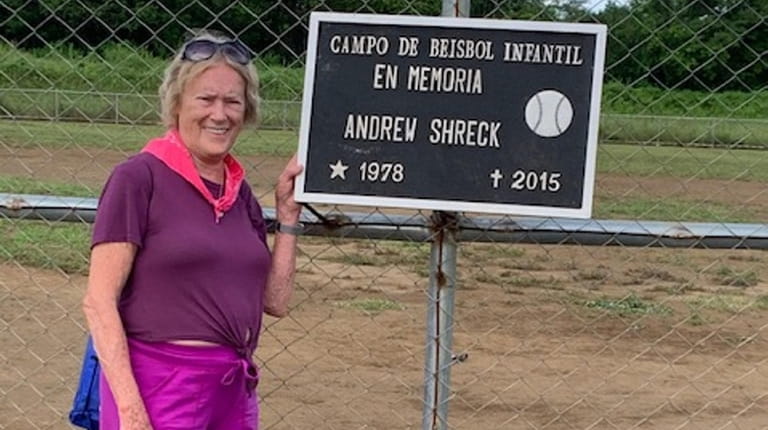
Kate Shreck poses with the plaque erected at the baseball field in honor of her son. When a 12-acre plot of land bought by the Friends of Students for 60,000 a decade ago was turned into a children's playground in addition to sports fields, the locals named the baseball field after one of Shreck's sons who died suddenly as an adult. Sports is always a draw, says co-founder Peter White. Sometimes they bring a suitcase of baseballs to give away, which helps speed their way through officialdom at airports. "They're like gold," he says. Credit: Friends of Students for 60,000
Lasting friendships
As with any project, there have been failures. Although the group provides labor and money to build homes, each resident is expected to complete it themselves. A small minority never finish. Along with this have come unexpected triumphs. Once on a visit to the country with a church group, Shreck made friends with a first-grader who said she wanted to be a doctor. The woman persuaded a physician along on the trip into handing over his stethoscope as an inspiration to the girl. Shreck lost contact with the girl despite later trips with the Friends and wrote it off as a lost cause. Then, six months ago, the girl reached out to her on Facebook and told her she was at a university studying to be a doctor.
“I thought she had fallen by the wayside,” Shreck says. “Sometimes you wonder if you are making a difference and then something like this happens.”
Members stress that all the money for their work goes to fund projects because they pay their own airfare and living expenses. Much of the impetus for their efforts continues to come from Peter White (known as “Pedro Blanco” in Nicaragua), who has pushed everyone from his personal doctor to public officials for assistance. This drive was noted by Steve Israel, the former longtime congressman from Long Island who worked with him and the students in the past.
“I had 800,000 constituents when I was in office, and Peter was one of the few who really understood how to make change in the world,” Israel says, then he laughs. “He’s the kind of guy who doesn’t take ‘Yes’ for an answer. He would ask for something, and I’d say, yes. Then he’d ask for something more.”
Although Friends of Students for 60,000 is composed primarily of senior citizens, it does draw younger members. Shari Kornblatt, 32, is a former Northport student who attends Friends meetings when possible — she now lives in Hoboken, New Jersey — and helps fundraising efforts. Her initial high school exposure affected her so much she formed her own humanitarian organization in college that rebuilt a rundown Nicaraguan elementary school that was about to be closed. Money raised by her group was used to buy the property — slated to be sold — in Chacraseca on which the school stood. Afterward, she signed the deed over to the education ministry.
“I couldn’t believe it,” she says. “I bought land in another country. And I did it in Spanish.”
Bringing lessons home
Now an instructor for a class of first-graders in Manhattan’s Gramercy Park neighborhood, she teaches them about less entitled parts of the world. To illustrate this, she brings in a gallon of water and briefly rests it on their heads to show them its weight, then explains how some Nicaraguan children in the villages they help have to carry 5-gallon buckets long distances back to their village. Or, how cleaning clothes there involves walking a mile to the river and a day of scrubbing in the hot sun. She has them practice on a large rock she brings to class and shows them pictures of herself doing the same alongside villagers.
“They say, look, there’s Ms. Kornblatt washing clothes,” she says.
Elisa Zazzera, 56, wasn’t surprised at the squalor she encountered on her trip to Nicaragua in 2016. An administrator for an association of mental health professionals who lives in upstate Hastings-on-Hudson, she has traveled the world on humanitarian issues, including to Egypt to spend a week with garbage pickers. Her experience helping construct a couple homes in Chacraseca was as hot and dirty as expected. On the other hand, she enjoyed the manual labor and even got to ride on a motorcycle to one of the work sites.
“What are we doing on this planet?” she says. “All we have is time. What better way to spend a week?”
Occasionally, members run into people not sympathetic to their efforts. White recalls talking about the group’s work to a friend who suddenly asked, “Why don’t you just leave them alone?” His point was that maybe people living a simple life were better left alone rather than being exposed to living standards that might not be sustainable, White explains.
Shocked by his indifference, White responded that just because people here were born in affluence doesn’t mean they should ignore the conditions of the less fortunate. At such times, he recalls how he asked a group of people in one of the villages what would have happened to them if their North American friends hadn’t helped out all those years ago.
White remembers one of the women smiling.
“Oh, that’s easy,” she told him. “We’d be dead.”
Want to be a 'Friend'?
Friends of Students for 60,000 fundraises primarily through mailings and social media publicity about upcoming trips. To join their donor base or contribute visit fsf60k.org or contact Peter White at Pedro831@optonline.net.
